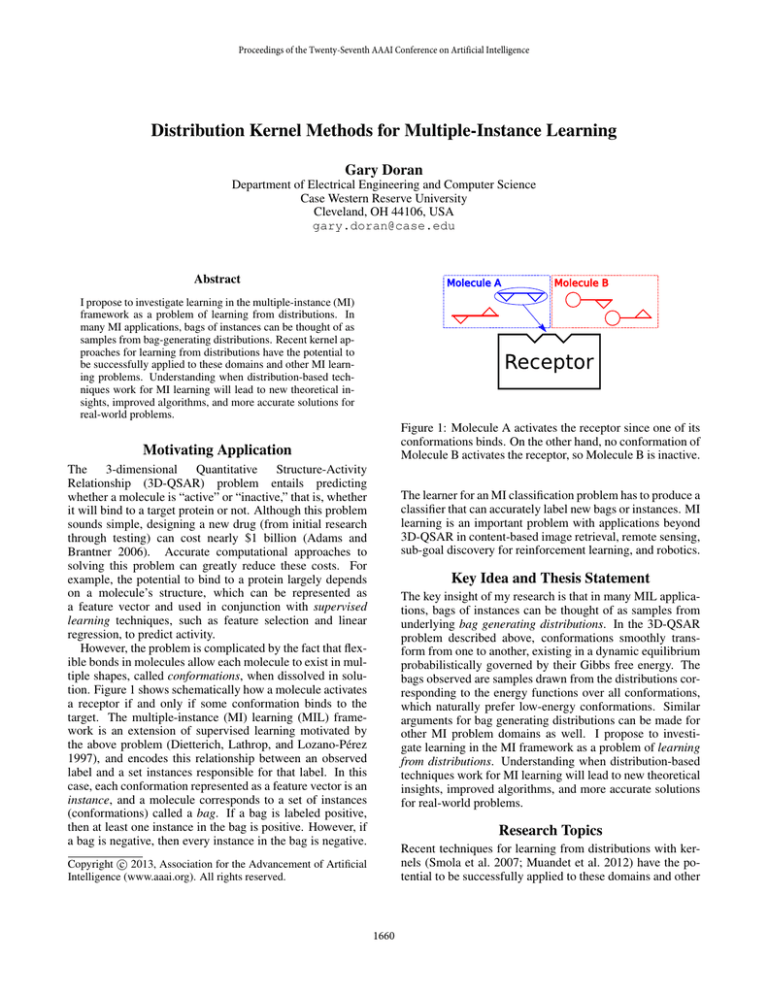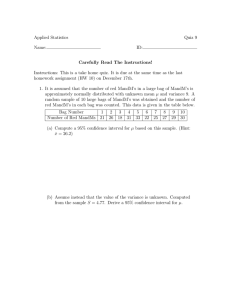
Proceedings of the Twenty-Seventh AAAI Conference on Artificial Intelligence
Distribution Kernel Methods for Multiple-Instance Learning
Gary Doran
Department of Electrical Engineering and Computer Science
Case Western Reserve University
Cleveland, OH 44106, USA
gary.doran@case.edu
Abstract
I propose to investigate learning in the multiple-instance (MI)
framework as a problem of learning from distributions. In
many MI applications, bags of instances can be thought of as
samples from bag-generating distributions. Recent kernel approaches for learning from distributions have the potential to
be successfully applied to these domains and other MI learning problems. Understanding when distribution-based techniques work for MI learning will lead to new theoretical insights, improved algorithms, and more accurate solutions for
real-world problems.
Figure 1: Molecule A activates the receptor since one of its
conformations binds. On the other hand, no conformation of
Molecule B activates the receptor, so Molecule B is inactive.
Motivating Application
The
3-dimensional
Quantitative
Structure-Activity
Relationship (3D-QSAR) problem entails predicting
whether a molecule is “active” or “inactive,” that is, whether
it will bind to a target protein or not. Although this problem
sounds simple, designing a new drug (from initial research
through testing) can cost nearly $1 billion (Adams and
Brantner 2006). Accurate computational approaches to
solving this problem can greatly reduce these costs. For
example, the potential to bind to a protein largely depends
on a molecule’s structure, which can be represented as
a feature vector and used in conjunction with supervised
learning techniques, such as feature selection and linear
regression, to predict activity.
However, the problem is complicated by the fact that flexible bonds in molecules allow each molecule to exist in multiple shapes, called conformations, when dissolved in solution. Figure 1 shows schematically how a molecule activates
a receptor if and only if some conformation binds to the
target. The multiple-instance (MI) learning (MIL) framework is an extension of supervised learning motivated by
the above problem (Dietterich, Lathrop, and Lozano-Pérez
1997), and encodes this relationship between an observed
label and a set instances responsible for that label. In this
case, each conformation represented as a feature vector is an
instance, and a molecule corresponds to a set of instances
(conformations) called a bag. If a bag is labeled positive,
then at least one instance in the bag is positive. However, if
a bag is negative, then every instance in the bag is negative.
The learner for an MI classification problem has to produce a
classifier that can accurately label new bags or instances. MI
learning is an important problem with applications beyond
3D-QSAR in content-based image retrieval, remote sensing,
sub-goal discovery for reinforcement learning, and robotics.
Key Idea and Thesis Statement
The key insight of my research is that in many MIL applications, bags of instances can be thought of as samples from
underlying bag generating distributions. In the 3D-QSAR
problem described above, conformations smoothly transform from one to another, existing in a dynamic equilibrium
probabilistically governed by their Gibbs free energy. The
bags observed are samples drawn from the distributions corresponding to the energy functions over all conformations,
which naturally prefer low-energy conformations. Similar
arguments for bag generating distributions can be made for
other MI problem domains as well. I propose to investigate learning in the MI framework as a problem of learning
from distributions. Understanding when distribution-based
techniques work for MI learning will lead to new theoretical
insights, improved algorithms, and more accurate solutions
for real-world problems.
Research Topics
Recent techniques for learning from distributions with kernels (Smola et al. 2007; Muandet et al. 2012) have the potential to be successfully applied to these domains and other
c 2013, Association for the Advancement of Artificial
Copyright Intelligence (www.aaai.org). All rights reserved.
1660
problems. For example, if bag sizes are small, then noisy instances might affect the value of the empirical mean map of
bag distributions. By computing the median rather than the
mean, a distribution might be embedded into a feature space
in a way that is more robust to noise. I have implemented
this “kernel median map” for the MI classification and regression problems, but more work is needed to theoretically
characterize the behavior of this approach.
MI learning problems. In particular, the kernel mean map
is an injective mapping of distributions into a feature space
that compactly represents distributions while preserving information relevant to the learning process. A related MI
kernel is the average-normalized set kernel (Gärtner et al.
2002), which is equivalent to an “empirical” mean map computed using samples from distributions. The properties of
these techniques raise several interesting theoretical questions related to when distribution-based learning can be applied successfully to MIL. The distribution-based learning
framework also suggests several novel methods and applications for MIL, described below.
Applications
I plan to integrate the MI regression approach described
above into a system that will evaluate the performance of
set kernels on real 3D-QSAR datasets, which will provide
a comparison to other techniques developed for this particular application. I am also exploring the application of MI
regression to problems in climate science such as the remote
sensing of aerosols using satellite measurements.
Theory
A key focus of my research is understanding which techniques for embedding distributions into feature spaces are
best suited for MIL. Set kernels lack a property I call soundness, which means that they allow zero-loss solutions that
are inconsistent with the MI assumption that at least one instance in each bag is positive. This property is unique to
MIL, since supervised learning algorithms are sound by construction. In other words, a support vector machine (SVM)
using the set kernel might “hallucinate” a solution that separates positive and negative bags in its feature space when no
solution exists that separates positive and negative instances
in the related instance feature space. Because this contradicts the logical relationship between instance and bag labels, it remains unclear why set kernels perform well for
MIL.
It is also important to understand when instance labels
can be learned from a bag (distribution) classifier. Some
prior work on learning theory for MIL assumes that each
bag is generated by drawing instances independently from
an underlying instance distribution (Blum and Kalai 1998).
However, as argued above, it often makes more sense to consider a hierarchical generative process in which each bag
is drawn from a distribution over bags, then each instance
in a bag is sampled according to a bag-specific distribution over instances. Other existing work describes when
instance or bag concepts are learnable in the probably approximately correct (PAC) framework from MI data using instance classifiers (Auer, Long, and Srinivasan 1997;
Blum and Kalai 1998; Sabato and Tishby 2012). However,
it remains unclear when learnability of instance concepts is
possible using algorithms that learn using bag-level distribution information. I will explore these learning theory questions into next year.
Conclusion
Understanding when distribution-based techniques work for
MI learning will lead to improved algorithms and more accurate solutions for real-world problems. Furthermore, my
research will more generally provide insight into the power
of distribution-based learning techniques for learning from
structured objects. These insights might illustrate when
these approaches can be successfully applied to the related
problems of learning from trees, graphs, and relational data.
References
Adams, C., and Brantner, V. 2006. Estimating the cost of
new drug development: is it really $802 million? Health
Affairs 25(2):420–428.
Auer, P.; Long, P.; and Srinivasan, A. 1997. Approximating
hyper-rectangles: Learning and pseudo-random sets. In Proceedings of the 29th Annual ACM Symposium on the Theory
of Computation, 314–323. ACM.
Blum, A., and Kalai, A. 1998. A note on learning from
multiple-instance examples. Machine Learning Journal
30:23–29.
Dietterich, T. G.; Lathrop, R. H.; and Lozano-Pérez, T.
1997. Solving the multiple instance problem with axisparallel rectangles. Artificial Intelligence 89(1–2):31–71.
Gärtner, T.; Flach, P.; Kowalczyk, A.; and Smola, A. 2002.
Multi-instance kernels. In Proceedings of the International
Conference on Machine Learning, 179–186.
Muandet, K.; Fukumizu, K.; Dinuzzo, F.; and Schölkopf,
B. 2012. Learning from distributions via support measure
machines. In Advances in Neural Information Processing
Systems. 10–18.
Sabato, S., and Tishby, N. 2012. Multi-instance learning
with any hypothesis class. Journal of Machine Learning Research 13:2999–3039.
Smola, A.; Gretton, A.; Song, L.; and Schölkopf, B. 2007.
A hilbert space embedding for distributions. In Algorithmic
Learning Theory, 13–31. Springer.
Methods
Distribution kernels might be used to solve other MI problems such as MI regression efficiently. The 3D-QSAR problem described above can also be formulated as an MI regression problem in which each molecule is labeled with a
real-valued activity level rather than a binary active/inactive
label. My current research suggests that set kernels can outperform state-of-the-art baselines on this task.
Techniques like the empirical mean map suggest other set
kernels that would be more well-suited for particular MIL
1661





